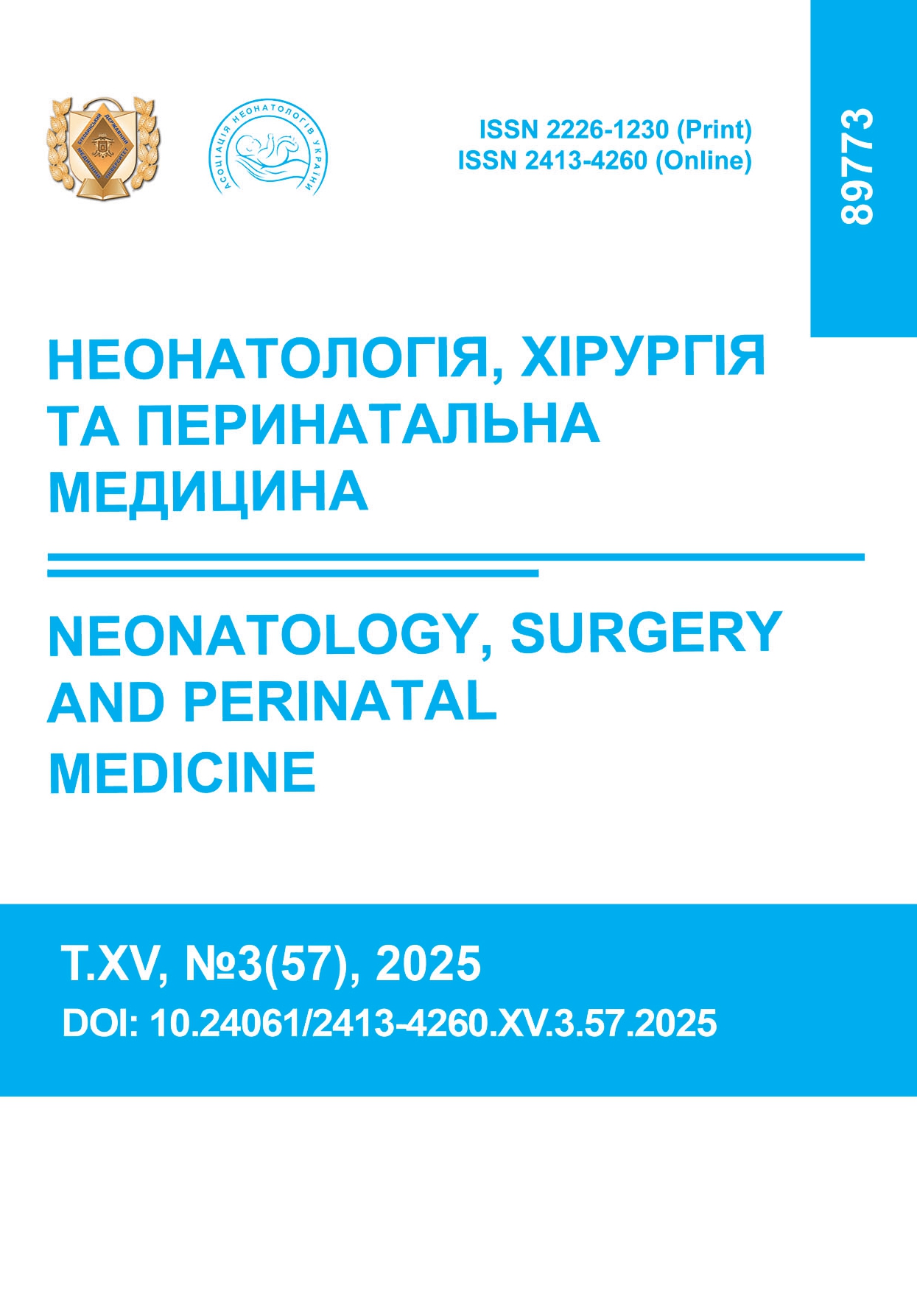ЗДОРОВ’ЯЗБЕРІГАЮЧІ ПРОГРАМИ, ПСИХІЧНЕ ЗДОРОВ’Я ТА ПСИХОСОЦІАЛЬНЕ БЛАГОПОЛУЧЧЯ ЯК ЧАСТИНА ЯКОСТІ ЖИТТЯ ДІТЕЙ ШКІЛЬНОГО ВІКУ
DOI:
https://doi.org/10.24061/2413-4260.XV.3.57.2025.22Ключові слова:
діти; здоров’язберігаючі шкільні програми; якість життя; фізична активність; психологічне здоров’я.Анотація
Сприятливе шкільне середовище та рівень фізичної активності є ключовим до покращення здоров’я в цілому та якості життя, пов’язаної зі здоров’ям (ЯЖПЗ) дитячого населення. Регулярна фізична активність у школярів сприяє покращанню фізичної форми, вищому серцево-метаболічному рівню, психічному здоров’ю та психосоціальному благополуччю.
Метою дослідження було вивчити вплив здоров’язберігаючої шкільної програми на якість життя дітей, особливо на психічне здоров’я.
Матеріал і методи. Проведено дослідження за участю 79 здорових школярів 11-12 років. Основна група дітей (32 особи) була залучена до спеціальної оздоровчої шкільної програми протягом одного року та отримані результати порівнювалася з даними контрольної групи (47 дітей). Для оцінки ЯЖПЗ загальний опитувальник CF-87 був використаний з особливою увагою до психологічного благополуччя, самооцінки та загального психічного здоров'я. При проведенні досліджень зберігалися рекомендовані принципи біоетики.
Результати. Застосована шкільна програма була спрямована на розвиток фізичної активності та оздоровлення дітей і поєднувалася зі співпрацею дітей в іграх та виконанні спільних завдань. Загальний рівень ЯЖПЗ був дещо кращим, показники психічної та психосоціальної самооцінки були достовірно вищими в основній групі ніж в контрольній (80,6±2,8% проти 68,2±3,3%, p<0,05). За попередній місяць діти основної групи відчули себе краще в навчанні, у вмінні займатися спортом, у навичках розмовляти та дружити з іншими, ладнати в родині.
Висновки. Це дослідження надає докази, що підтверджують ефективність шкільних програм зі збереження здоров’я, які покращують фізичну активність і позитивно впливають на якість життя дітей, особливо на психічне здоров’я та психосоціальну самооцінку.
Посилання
Wennergren M, Berg K, Frisk Cavefors AS, Edin H, Ekholm L, Gelander L, et al. Swedish Child Health Services Register: a quality register for child health services and children's well-being. BMJ Paediatr Open. 2023;7(1):e001805. DOI: https://doi.org/10.1136/bmjpo-2022-001805. PMID: 36669832; PMCID: PMC9872488.
Ahmed SM, Rawal LB, Chowdhury SA, Murray J, Arscott-Mills S, Jack S, et al. Cross-country analysis of strategies for achieving progress towards global goals for women's and children's health. Bull World Health Organ. 2016;94(5):351-61. DOI: https://doi.org/10.2471/blt.15.168450. PMID: 27147765; PMCID: PMC4850533.
Garces A, MacGuire E, Franklin HL, Alfaro N, Arroyo G, Figueroa L, et al. Looking beyond the numbers: quality assurance procedures in the Global Network for Women's and Children's Health Research Maternal Newborn Health Registry. Reprod Health. 2020;17(S2):159. DOI: https://doi.org/10.1186/s12978-020-01009-3. PMID: 33256778; PMCID: PMC7708152.
Neil-Sztramko SE, Caldwell H, Dobbins M. School-based physical activity programs for promoting physical activity and fitness in children and adolescents aged 6 to 18. Cochrane Database Syst Rev. 2021;9(9):CD007651. DOI: https://doi.org/10.1002/14651858.cd007651.pub3. PMID: 34555181; PMCID: PMC8459921.
Brazendale K, Beets MW, Armstrong B, Weaver RG, Hunt ET, Pate RR, et al. Children's moderate-to-vigorous physical activity on weekdays versus weekend days: a multi-country analysis. Int J Behav Nutr Phys Act. 2021;18(1):28. DOI: https://doi.org/10.1186/s12966-021-01095-x. PMID: 33568183; PMCID: PMC7877033.
Wunsch K, Nigg CR, Weyland S, Jekauc D, Niessner C, Burchartz A, et al. The relationship of self-reported and device-based measures of physical activity and health-related quality of life in adolescents. Health Qual Life Outcomes. 2021;19(1):67. DOI: https://doi.org/10.1186/s12955-021-01682-3. PMID: 33648492; PMCID: PMC7923541.
Bull FC, Al-Ansari SS, Biddle S, Borodulin K, Buman MP, Cardon G, et al. World Health Organization 2020 guidelines on physical activity and sedentary behaviour. Br J Sports Med. 2020;54(24):1451-62. DOI: https://doi.org/10.1136/bjsports-2020-102955. PMID: 33239350; PMCID: PMC7719906.
Ram B, Foley KA, van Sluijs E, Hargreaves DS, Viner RM, Saxena S. Developing a core outcome set for physical activity interventions in primary schools: a modified-Delphi study. BMJ Open. 2022;12(9):e061335. DOI: https://doi.org/10.1136/bmjopen-2022-061335. PMID: 36180126; PMCID: PMC9528589.
Arakelyan S, Ager A. Annual Research Review: A multilevel bioecological analysis of factors influencing the mental health and psychosocial well-being of refugee children. J Child Psychol Psychiatry. 2021;62(5):484-509. DOI: https://doi.org/10.1111/jcpp.13355. PMID: 33277944; PMCID: PMC8246898.
Anderson YC, Wynter LE, Treves KF, Grant CC, Stewart JM, Cave TL, et al. Assessment of health-related quality of life and psychological well-being of children and adolescents with obesity enrolled in a New Zealand community-based intervention programme: an observational study. BMJ Open. 2017;7(8):e015776. DOI: https://doi.org/10.1136/bmjopen-2016-015776. PMID: 28794060; PMCID: PMC5629647.
Aronu AE, Uwaezuoke SN, Muoneke UV. Reliability of generic quality-of-life instruments in assessing health-related quality of life among children and adolescents with idiopathic nephrotic syndrome: a systematic review. Health Qual Life Outcomes. 2021;19(1):144. DOI: https://doi.org/10.1186/s12955-021-01786-w. PMID: 33980318; PMCID: PMC8209644.
Kovalchuk T, Boyarchuk O. Pokaznyky yakosti zhyttia u ditei iz netravmatychnymy nesynkopalnymy tranzytornymy vtratamy svidomosti ta yikhnikh rodyn [Quality of life indicators in children with non-traumatic and non-syncopal transient loss of consciousness and their families]. Child`s health. 2023;18(1):40-6. https://doi.org/10.22141/2224-0551.18.1.2023.1557 (in Ukrainian)
Abassi H, Huguet H, Picot MC, Vincenti M, Guillaumont S, Auer A, et al. Health-related quality of life in children with congenital heart disease aged 5 to 7 years: a multicentre controlled cross-sectional study. Health Qual Life Outcomes. 2020;2;18(1):366. DOI: https://doi.org/10.1186/s12955-020-01615-6. PMID: 33183312; PMCID: PMC7659069.
Ngwira LG, Maheswaran H, Verstraete J, Petrou S, Niessen L, Smith SC. Psychometric performance of the Chichewa versions of the EQ-5D-Y-3L and EQ-5D-Y-5L among healthy and sick children and adolescents in Malawi. J Patient Rep Outcomes. 2023;7(1):22. DOI: https://doi.org/10.1186/s41687-023-00560-4. PMID: 36892714; PMCID: PMC9996597.
Ohrnberger J, Anselmi L, Fichera E, Sutton M. Validation of the SF12 mental and physical health measure for the population from a low-income country in sub-Saharan Africa. Health Qual Life Outcomes. 2020;18(1):78. DOI: https://doi.org/10.1186/s12955-020-01323-1. PMID: 32188461; PMCID: PMC7081543.
Kwon J, Freijser L, Huynh E, Howell M, Chen G, Khan K, et al. Systematic Review of Conceptual, Age, Measurement and Valuation Considerations for Generic Multidimensional Childhood Patient-Reported Outcome Measures. Pharmacoeconomics. 2022;40(4):379-431. DOI: https://doi.org/10.1007/s40273-021-01128-0. Erratum in: Pharmacoeconomics. 2022;40(4):477-8. DOI: https://doi.org/10.1007/s40273-022-01135-9. PMID: 35072935; PMCID: PMC9007803.
Khanna D, Khadka J, Mpundu-Kaambwa C, Ratcliffe J; Quality of Life in Kids: Key Evidence to Strengthen Decisions in 6 Australia (QUOKKA) Project Team. Child-Parent Agreement in the Assessment of Health-Related Quality of Life Using the CHU9D and the PedsQLTM. Appl Health Econ Health Policy. 2023;21(6):937-47. DOI: https://doi.org/10.1007/s40258-023-00831-7. PMID: 37773319; PMCID: PMC10627990.
Masini A, Gori D, Marini S, Lanari M, Scrimaglia S, Esposito F, et al. The Determinants of Health-Related Quality of Life in a Sample of Primary School Children: A Cross-Sectional Analysis. Int J Environ Res Public Health. 2021;18(6):3251. DOI: https://doi.org/10.3390/ijerph18063251. PMID: 33801105; PMCID: PMC8004180.
Mierau JO, Kann-Weedage D, Hoekstra PJ, Spiegelaar L, Jansen DEMC, Vermeulen KM, et al. Assessing quality of life in psychosocial and mental health disorders in children: a comprehensive overview and appraisal of generic health related quality of life measures. BMC Pediatr. 2020;20(1):329. DOI: https://doi.org/10.1186/s12887-020-02220-8. PMID: 32620157; PMCID: PMC7333319.
Bermejo-Cantarero A, Alvarez-Bueno C, Martinez-Vizcaino V, Redondo-Tebar A, Pozuelo-Carrascosa DP, Sanchez-Lopez M. Relationship between both cardiorespiratory and muscular fitness and health-related quality of life in children and adolescents: a systematic review and meta-analysis of observational studies. Health Qual Life Outcomes. 2021;19(1):127. DOI: https://doi.org/10.1186/s12955-021-01766-0. PMID: 33882937; PMCID: PMC8059195.
Martinsen KD, Neumer SP, Holen S, Waaktaar T, Sund AM, Kendall PC. Self-reported quality of life and self-esteem in sad and anxious school children. BMC Psychol. 2016;4(1):45. DOI: https://doi.org/10.1186/s40359-016-0153-0. PMID: 27624487; PMCID: PMC5022161.
Calzada-Rodriguez JI, Denche-Zamorano AM, Perez-Gomez J, Mendoza-Munoz M, Carlos-Vivas J, Barrios-Fernandez S, et al. Health-Related Quality of Life and Frequency of Physical Activity in Spanish Students Aged 8-14. Int J Environ Res Public Health. 2021;18(17):9418. DOI: https://doi.org/10.3390/ijerph18179418. PMID: 34502002; PMCID: PMC8430964.
Denche-Zamorano A, Pastor-Cisneros R, Moreno-Moreno L, Carlos-Vivas J, Mendoza-Munoz M, Contreras-Barraza N, Gil-Marin M, et al. Physical Activity Frequency and Health-Related Quality of Life in Spanish Children and Adolescents with Asthma: A Cross-Sectional Study. Int J Environ Res Public Health. 2022;19(21):14611. DOI: https://doi.org/10.3390/ijerph192114611. PMID: 36361489; PMCID: PMC9658524.
O'Loughlin R, Hiscock H, Pan T, Devlin N, Dalziel K. The relationship between physical and mental health multimorbidity and children's health-related quality of life. Qual Life Res. 2022;31(7):2119-31. DOI: https://doi.org/10.1007/s11136-022-03095-1. PMID: 35094215; PMCID: PMC9188523.
Otto C, Haller AC, Klasen F, Holling H, Bullinger M, Ravens-Sieberer U; BELLA study group. Risk and protective factors of health-related quality of life in children and adolescents: Results of the longitudinal BELLA study. PLoS One. 2017;12(12):e0190363. DOI: https://doi.org/10.1371/journal.pone.0190363. PMID: 29284054; PMCID: PMC5746247.
Watts TW, Nguyen T, Carr RC, Vernon-Feagans L, Blair C. Examining the Effects of Changes in Classroom Quality on Within-Child Changes in Achievement and Behavioral Outcomes. Child Dev. 2021;92(4):e439-e456. DOI: https://doi.org/10.1111/cdev.13552. PMID: 33782953; PMCID: PMC9279005.
Wu XY, Han LH, Zhang JH, Luo S, Hu JW, Sun K. The influence of physical activity, sedentary behavior on health-related quality of life among the general population of children and adolescents: A systematic review. PLoS One. 2017;12(11):e0187668. DOI: https://doi.org/10.1371/journal.pone.0187668. PMID: 29121640; PMCID: PMC5679623.
Wang J, Jin W, Shi L, Geng Y, Zhu X, Hu W. Health-Related Quality of Life in Children: The Roles of Age, Gender and Interpersonal Trust. Int J Environ Res Public Health. 2022;19(22):15408. DOI: https://doi.org/10.3390/ijerph192215408. PMID: 36430127; PMCID: PMC9690605.
Villafaina S, Tapia-Serrano MA, Vaquero-Solis M, Leon-Llamas JL, Sanchez-Miguel PA. The Role of Physical Activity in the Relationship between Satisfaction with Life and Health-Related Quality of Life in School-Age Adolescents. Behav Sci (Basel). 2021;11(9):121. DOI: https://doi.org/10.3390/bs11090121. PMID: 34562959; PMCID: PMC8467321.
##submission.downloads##
Опубліковано
Як цитувати
Номер
Розділ
Ліцензія

Ця робота ліцензується відповідно до Creative Commons Attribution 4.0 International License.
Автори, які публікуються у цьому журналі, погоджуються з наступними умовами:
- Автори залишають за собою право на авторство своєї роботи та передають журналу право першої публікації цієї роботи на умовах ліцензії Creative Commons Attribution License, котра дозволяє іншим особам вільно розповсюджувати опубліковану роботу з обов'язковим посиланням на авторів оригінальної роботи та першу публікацію роботи у цьому журналі.
- Автори мають право укладати самостійні додаткові угоди щодо неексклюзивного розповсюдження роботи у тому вигляді, в якому вона була опублікована цим журналом (наприклад, розміщувати роботу в електронному сховищі установи або публікувати у складі монографії), за умови збереження посилання на першу публікацію роботи у цьому журналі.
- Політика журналу дозволяє і заохочує розміщення авторами в мережі Інтернет (наприклад, у сховищах установ або на особистих веб-сайтах) рукопису роботи, як до подання цього рукопису до редакції, так і під час його редакційного опрацювання, оскільки це сприяє виникненню продуктивної наукової дискусії та позитивно позначається на оперативності та динаміці цитування опублікованої роботи (див. The Effect of Open Access).
Критерії авторського права, форми участі та авторства
Кожен автор повинен був взяти участь в роботі, щоб взяти на себе відповідальність за відповідні частини змісту статті. Один або кілька авторів повинні нести відповідальність в цілому за поданий для публікації матеріал - від моменту подачі до публікації статті. Авторитарний кредит повинен грунтуватися на наступному:
- істотність частини вклада в концепцію і дизайн, отри-мання даних або в аналіз і інтерпретацію результатів дослідження;
- написання статті або критичний розгляд важливості її інтелектуального змісту;
- остаточне твердження версії статті для публікації.
Автори також повинні підтвердити, що рукопис є дійсним викладенням матеріалів роботи і що ні цей рукопис, ні інші, які мають по суті аналогічний контент під їх авторством, не були опубліковані та не розглядаються для публікації в інших виданнях.
Автори рукописів, що повідомляють вихідні дані або систематичні огляди, повинні надавати доступ до заяви даних щонайменше від одного автора, частіше основного. Якщо потрібно, автори повинні бути готові надати дані і повинні бути готові в повній мірі співпрацювати в отриманні та наданні даних, на підставі яких проводиться оцінка та рецензування рукописи редактором / членами редколегії журналу.
Роль відповідального учасника.
Основний автор (або призначений відповідальний автор) буде виступати від імені всіх співавторів статті в якості основного кореспондента при листуванні з редакцією під час процесу її подання та розгляду. Якщо рукопис буде прийнята, відповідальний автор перегляне відредагований машинописний текст і зауваження рецензентів, прийме остаточне рішення щодо корекції і можливості публікації представленої рукописи в засобах масової інформації, федеральних агентствах і базах даних. Він також буде ідентифікований як відповідальний автор в опублікованій статті. Відповідальний автор несе відповідальність за подтверждленіе остаточного варіанта рукопису. Відповідальний автор несе також відповідальність за те, щоб інформація про конфлікти інтересів, була точною, актуальною і відповідала даним, наданим кожним співавтором.Відповідальний автор повинен підписати форму авторства, що підтверджує, що всі особи, які внесли істотний внесок, ідентифіковані як автори і що отримано письмовий дозвіл від кожного учасника щодо публікації представленої рукописи.
















